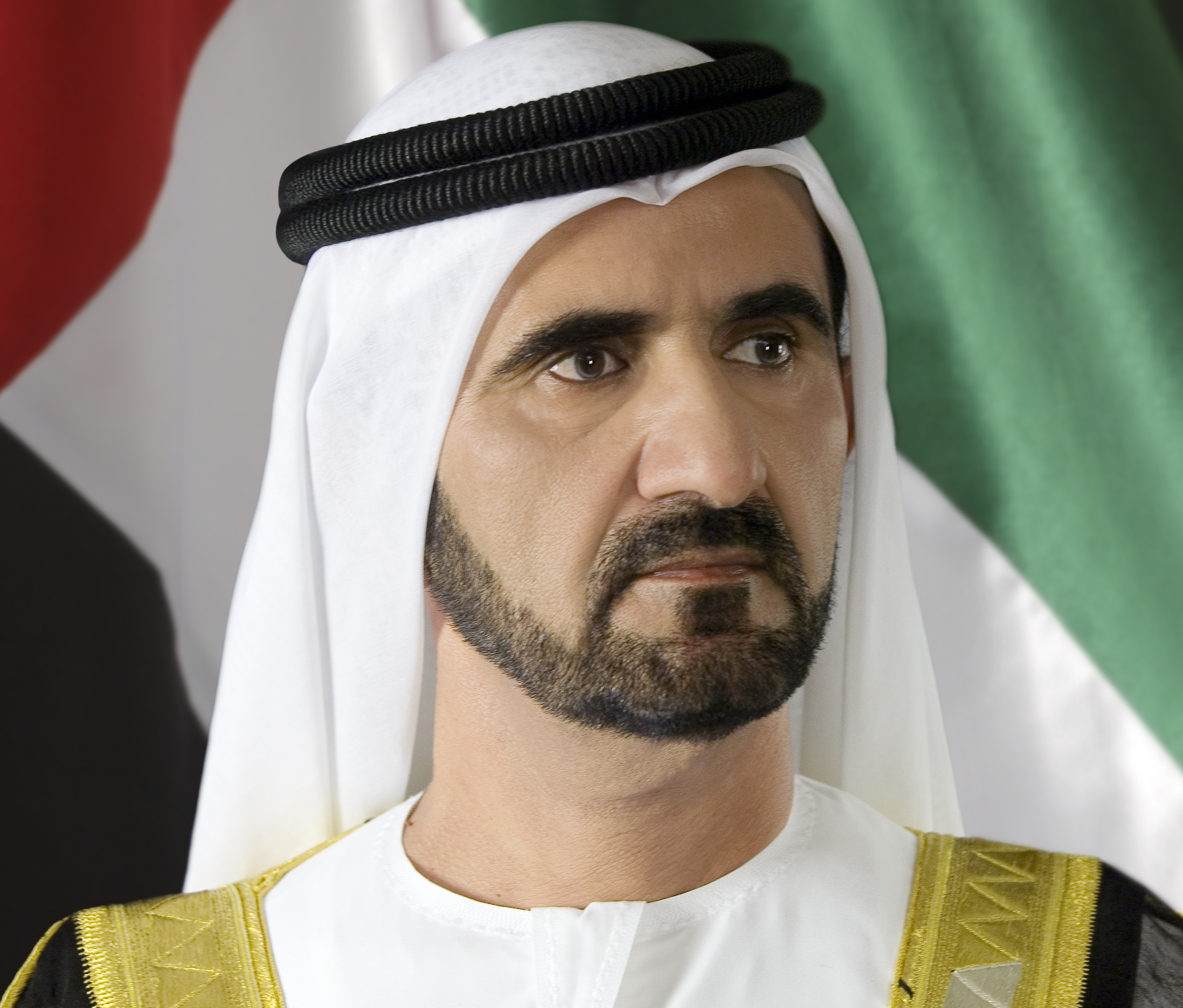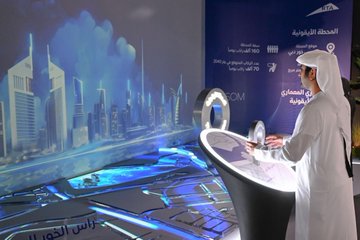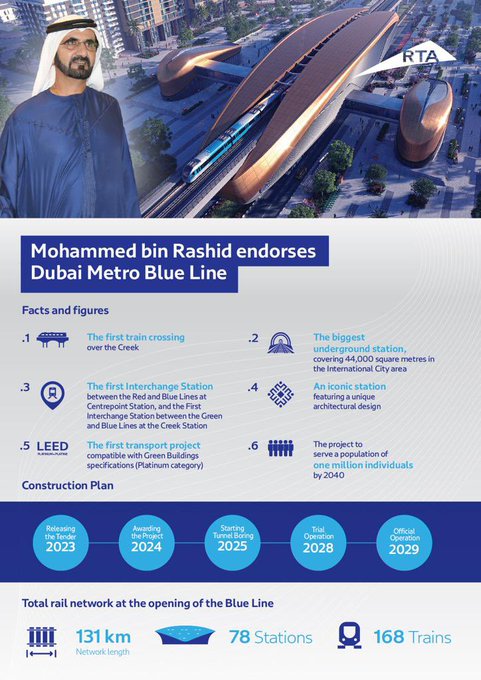- City Fajr Shuruq Duhr Asr Magrib Isha
- Dubai 05:44 07:02 12:29 15:27 17:50 19:08



His Highness Sheikh Mohammed bin Rashid Al Maktoum, Vice President and Prime Minister of UAE and Ruler of Dubai, has approved the Dubai Metro Blue Line project, a new 30 km metro route that will strategically link key areas in the emirate through 14 stations, in line with the anticipated growth of around one million residents outlined in the Dubai 2040 Urban Master Plan.
HH Sheikh Mohammed underscored that investments in infrastructure projects align with Dubai's strategy for comprehensive city development, focusing on meeting present needs while preparing for the future. He emphasised that national talents have proven their ability to spearhead development, offering creative ideas that resonate with Dubai's ambitious objectives in various fields, driving progress and excellence.
“Remarkable achievements don't happen by chance; rather, they result from deliberate planning, creative thinking and a commitment to attaining the highest levels of leadership. The true measure of achievement lies in its positive impact on society. We strive for the best for our society, sparing no effort to achieve it at the highest standards,” His Highness said.
His Highness directed the immediate commencement of the project's implementation, adhering to the highest international standards and specifications to meet the demands of demographic expansion in the region. The project is scheduled for completion in 2029, coinciding with the 20th anniversary of the Dubai Metro.
During a ceremony held at Dubai Creek Harbour, His Highness Sheikh Maktoum bin Mohammed bin Rashid Al Maktoum, First Deputy Ruler of Dubai and Deputy Prime Minister and Minister of Finance of the UAE, launched the Dubai Metro Blue Line project.
Sheikh Maktoum said that, guided by the vision and directives of HH Sheikh Mohammed bin Rashid Al Maktoum, Dubai remains committed to implementing world-class projects that not only enhance the city’s global standing but also reaffirm its leadership in developing high-level infrastructure that aligns with the emirate's sustainable development goals.
"We remain dedicated to upholding the vision of HH Sheikh Mohammed bin Rashid, which seeks to consolidate Dubai’s position as the world’s best city to live in,” Sheikh Maktoum noted.
His Highness commended the Dubai Roads and Transport Authority for its efforts in implementing major projects that align with Dubai's future aspirations. He also acknowledged the valuable contributions of Emirati talent at the forefront of development across vital sectors in Dubai. “We are proud of our national talent and have full confidence in their abilities to further develop the emirate, with a focus on enhancing the stability and happiness of the community.”
The ceremony was also attended by His Highness Sheikh Ahmed bin Saeed Al Maktoum, Chairman and Chief Executive of Emirates Airline and Group, His Highness Sheikh Mansoor bin Mohammed bin Rashid Al Maktoum, Chairman of Dubai Ports and Borders Security Council, and a number of senior officials.
Upon his arrival at the ceremony, HH Sheikh Maktoum was welcomed by His Excellency Mattar Al Tayer, Director-General and Chairman of the Board of Executive Directors of the Roads and Transport Authority (RTA). His Highness was briefed on the key features of the Dubai Metro Blue Line which were showcased on a massive mural at the venue.
The Blue Line represents a significant advancement as the first metro route crossing Dubai Creek through a 1300-metre viaduct. The Blue Line will span a total length of 30 km, with 15.5 km running underground and 14.5 km above ground.
With its 14 stations, including key interchange points like the Creek Station on the Green Line, Centrepoint Station on the Red Line, and Dubai International City Station 1, along with the iconic station at Dubai Creek Harbour, the Blue Line is set to be a pivotal element in the ongoing development of the city's transportation network.
Best City in the World
The new line is a key integration point between the Red and Green Lines of Dubai Metro. It plays a significant role in realising the objectives of the Dubai Economic Agenda (D33) and Dubai 2040 Urban Master Plan aimed at transforming Dubai into the world’s best city to live in by offering sustainable and soft mass transit solutions. These solutions are designed to facilitate the mobility of both residents and visitors, promoting well-being and enhancing Dubai's global competitiveness as a leading destination for hosting international events. Additionally, they align with the aspirations of the Dubai 2040 Urban Master Plan, which aims to create a '20-minute city.' This innovative concept ensures that more than 80% of essential services are within a 20-minute travel time for residents, fostering a Transit-Oriented Development (TOD) approach.
Nine Key Areas
The Blue Line will offer a direct connection between Dubai International Airport and nine key areas along the line namely Mirdif, Al Warqa, International City 1 and 2, Dubai Silicon Oasis, Academic City, Ras Al Khor Industrial Area, Dubai Creek Harbour and Dubai Festival City. The travel time between these destinations is anticipated to range from 10 to 25 minutes.
The Blue Line consists of nine elevated stations and five underground stations. By 2030, the Blue Line is anticipated to serve approximately 200,000 passengers daily, with this figure expected to increase to 320,000 passengers daily by 2040. The line is designed to handle an estimated capacity of about 56,000 passengers per hour in both directions at a service interval of about 1.5 minutes.
During the event, HH Sheikh Maktoum viewed models of the designs for both the upper and tunnel sections of the Blue Line stations. He then marked the location on a large model depicting the project's service areas, which also highlighted the position of the iconic station in the Dubai Creek Harbour. This station embodies an innovative design that reflects the vision of the new Dubai. This design seamlessly integrates with the urban style of the surrounding modern residential and commercial towers. Spanning 8,800 square meters, the station is engineered to accommodate approximately 160,000 passengers daily, with a projected increase to around 70,000 passengers daily by 2040.
HH Sheikh Maktoum bin Mohammed also met with 30 young Emirati engineers who will be part of the team entrusted to construct the Dubai Metro Blue Line project. This team represents a continuation of the skilled professionals who contributed to the construction of earlier rail projects.
5th Strategic Project
Dubai Metro Blue Line represents the fifth strategic project in public transportation, joining the ranks of the existing Red and Green Lines of the Dubai Metro, Dubai Tram and Dubai Metro Route 2020. It is one of the largest strategic projects in the transportation sector for the upcoming phase.
Upon the completion of the Blue Line, Dubai's total railway network will extend from 101 km to 131 km. This includes 120 km for the Dubai Metro and 11 km for Dubai Tram. The number of metro and tram stations will increase from 64 to 78, encompassing 67 stations for the Dubai Metro and 11 for the Dubai Tram. Additionally, the fleet will expand from 140 to 168 trains, including 157 for the Dubai Metro and 11 for the Dubai Tram.
HH Sheikh Maktoum bin Mohammed was briefed by HE Mattar Al Tayer on the Dubai Metro Blue Line, which links the Green Line at Creek Station with the Red Line at Centrepoint Station, catering to residential, academic areas and developmental projects.
The line will also serve one of the urban centres highlighted in the Dubai 2040 Urban Master Plan, namely the Dubai Silicon Oasis Centre, a knowledge and innovation international hub playing a crucial role in advancing the knowledge and technology economy sector and attracting talented and innovative individuals.
During the event, Al Tayer said: “Dubai Metro Blue Line comprises two main routes. The first route begins at the Creek Interchange Station on the Green Line, located in Al Jaddaf. It then passes through Dubai Festival City, Dubai Creek Harbour and Ras Al Khor, before reaching Dubai International City 1, which has an interchange station. The route continues towards Dubai International City 2 and 3, extending to Dubai Silicon Oasis and up to the Academic City. This section spans 21 km and features 10 stations.
“The second route of the Blue Line starts from Centrepoint Interchange Station on the Red Line in Al Rashidiya. It passes through Mirdif and Al Warqaa, concluding at the Dubai International City 1 Interchange Station. This route measures 9 km in length and includes four stations. The project also includes the construction of a metro depot at Al Ruwayyah 3.”
Iconic Station
Al Tayer added: “The Dubai Metro Blue Line stands out with several notable features, including an iconic station at Dubai Creek Harbour featuring distinctive architectural design. This landmark station will be crafted by the globally renowned firm Skidmore, Owings and Merrill (SOM), one of the largest architectural offices worldwide. SOM is renowned for designing iconic structures such as the Burj Khalifa, the Denver Union Railroad Station in Colorado and the Sears Tower in Chicago. Additionally, the Blue Line boasts the largest underground interchange station within the metro network, covering an expansive area of 44,000 square meters, designed to accommodate approximately 350,000 passengers daily. Notably, the Blue Line sets a precedent as the first transport project of its kind to adhere to green building regulations and specifications, achieving platinum category status.”
50,000 University Students
Al Tayer explained that the Dubai Metro Blue Line was meticulously planned with sustainability in mind, ensuring it connects various densely populated areas and projects. By 2040, it is anticipated to serve regions with a combined population of around one million individuals. Key areas served by the Blue Line include Dubai Creek Harbour and Dubai Festival City, noted for their immense development potential, as well as Dubai International City, home to Dragon Mart and large residential complexes visited by over 200,000 residents and visitors., he noted.
The Blue Line also serves residential neighbourhoods like Al Rashidiya, Al Warqa, and Mirdif. It also extends to Dubai Silicon Oasis, recognised as one of Dubai 2040 Urban Master Plan’s Urban Centres, and the Academic City, which is projected to accommodate over 50,000 university students by 2029, Al Tayer added.
The construction of the Blue Line project will utilise cutting-edge international technologies in train systems. Station designs have been planned to maximise space efficiency, thereby reducing implementation, operation and maintenance costs. Additionally, these designs aim for seamless integration with various transportation modes, including public buses and taxis.
Economic Return
Initial studies by RTA indicated that infrastructure investment is a key driver of economic growth in cities worldwide. The Dubai Metro Blue Line project aligns with the objectives of the Dubai Economic Agenda, D33, offering economic, social and environmental returns. By 2040, the project is projected to yield a benefit-cost ratio of 2.60 (AED2.60 in benefits for every AED1 spent). The total anticipated benefits exceed AED56.5 billion by 2040. These benefits include substantial savings in time and fuel, reduced accident-related fatalities and lower carbon emissions.
The Blue Line is also expected to decrease traffic congestion on its served routes by 20% and appreciate the value of land and properties near stations by up to 25%. The Blue Line also provides a direct connection between Dubai International Airport and nine key areas situated along its route. It connects with the fifth urban centre, Dubai Silicon Oasis Centre, ensuring that all major urban centres in Dubai are seamlessly connected by metro lines.
The endorsement of the Dubai Metro Blue Line signifies a major milestone, building upon the huge success Dubai Metro has achieved since its inauguration on 9/9/2009. The Metro has emerged as the backbone of Dubai's transportation network, becoming the preferred mode of travel for both residents and visitors. It represents nearly 60% of the total usage across all public transportation modes in Dubai, which include buses, the Dubai Tram, and marine transport means.
Up to last October, Dubai Metro has lifted 2.2 billion passengers since its inauguration and has averaged over 685,000 passengers daily in 2023. The Dubai Metro has also recorded great success in upholding the highest international safety standards and operational efficiency, boasting a 99.7% punctuality.
Dubai Metro played a pivotal role in boosting Dubai's competitiveness for hosting major international events, including the successfully hosted Expo 2020 Dubai. This event coincided with the launch of the Dubai Metro Route 2020, a 15 km extension featuring seven new stations. It has also contributed to stimulating economic growth, boosting tourism, and enhancing the value of properties located near its stations.
Global Standing
Dubai Metro maintains its position as the world's longest driverless metro network, with a current total length of 90 km. This network includes around 52 km dedicated to the Red Line, 23 km for the Green Line, and 15 km for Route 2020. The network comprises 53 stations, with 29 on the Red Line, 18 on the Green Line, and six on Route 2020. Additionally, the fleet consists of 129 trains. The facilities and services offered at the Dubai Metro stations are recognised as some of the best globally.
Art Show
The ceremony at Dubai Creek Harbour included a live musical performance by an orchestra that played a unique composition celebrating the Dubai Metro Blue Line project. The artistic display included a flight of 2,500 drones over Dubai Creek, creating a 3D image of HH Sheikh Mohammed bin Rashid Al Maktoum, followed by a visual journey highlighting key historical moments of the Dubai Metro from 2009 to 2023. The drones then traced the path of the new Blue Line, soaring over the metro bridge across Dubai Creek and towards Dubai Creek Harbour. In parallel, Dubai Ferry passed beneath, accompanied by a fireworks display. The show culminated in a grand finale, with fireworks illuminating the sky in shades of blue and white.
Facts & Figures
- The Dubai Metro's total network length is approximately 90 km, comprising 52 km for the Red Line, 23 km for the Green Line, and 15 km for Route 2020.
- Each train consists of five air-conditioned carriages, accommodating around 650 passengers, and operates autonomously without a driver.
- Since its inauguration in September 2009 until last October, the Dubai Metro has served approximately 2.2 billion passengers.
- The network's design allows for handling about 26,000 passengers per hour in each direction on both the Red and Green Lines.
- The network incorporates three multi-level parking facilities, offering over 8,000 parking spaces in total.
- The interior designs of metro stations across the Red and Green Lines, including Route 2020, are themed around six concepts:
- Heritage: Reflecting the rich culture and history of the UAE
- Earth: Representing the enduring aspects of nature
- Air: Symbolising the essence of life and its ongoing flow
- Fire: Source of energy and power
- Water: Basis of life and source of inspiration
- Future Dubai Design: Iconic Expo station
![]() Follow Emirates 24|7 on Google News.
Follow Emirates 24|7 on Google News.